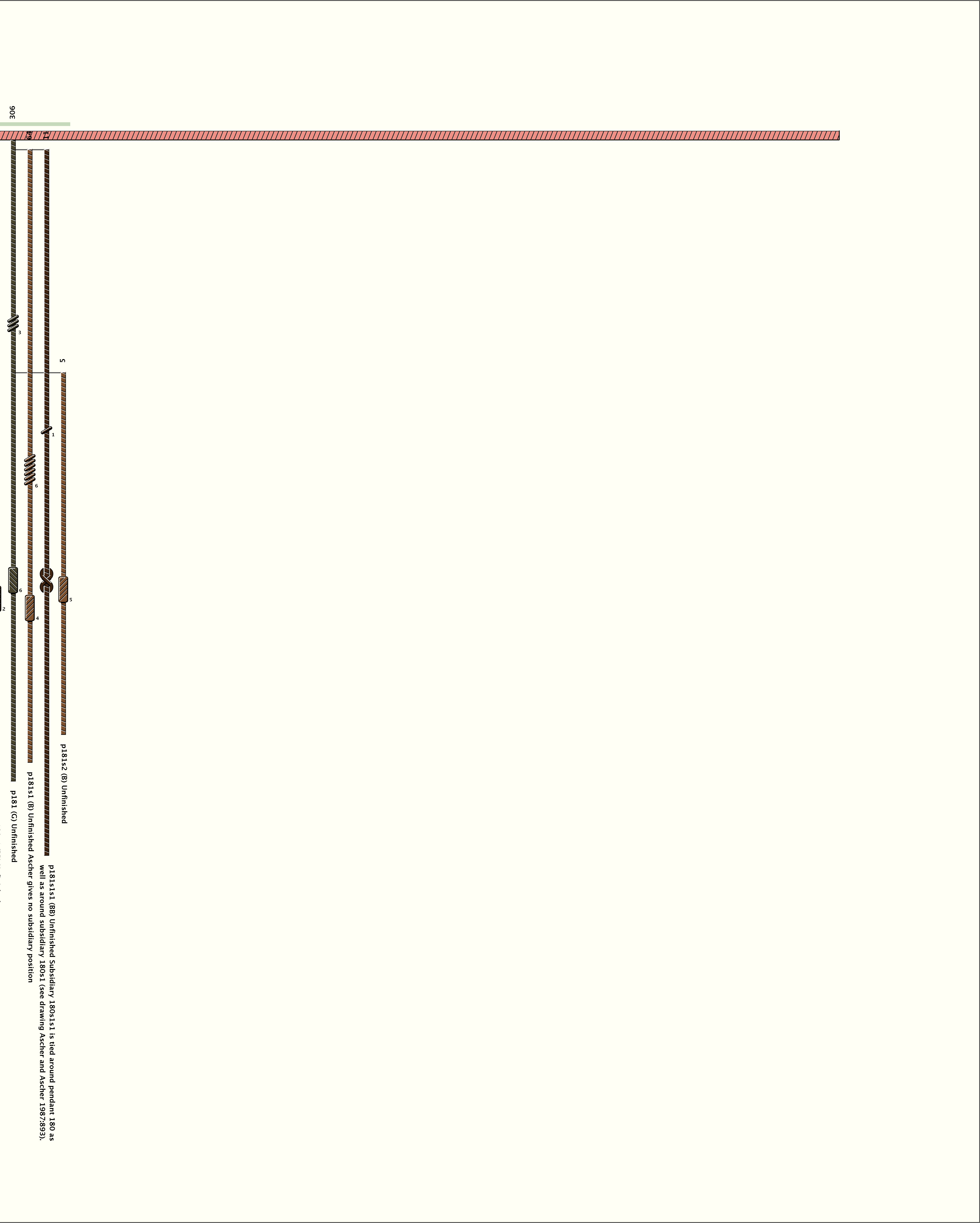UR1136/KH0152
|
Original Name: AS136 Original Author: Marcia & Robert Ascher Museum: Museum für Völkerkunde, Berlin, Germany Museum Number: VA16635 Provenance: Unknown Region: Nazca |
Total Number of Cords: 285 Number of Ascher Cord Colors: 7 Similar Khipu: Previous (AS195) Next (UR1175) Catalog: UR1136 Khipu Notes: Khipu Notes |



Khipu Notes
- The khipu is attached to a carved wooden bar./li>
- Marker M1 is a cord of length 49.0 cm. tied around the main cord.
- Subsidiary 180s1s1 is tied around pendant 180 as well as around subsidiary 180s1.
- UR1136 and UR1140 were acquired by the Museum in 1904. The provenance is given as Nasca. For a comparison of them, see #10 below.
- Photographs of UR1136 are in Ascher (1975) and Schmidt, Max, 1929, Kunst und Kultur von Peru, Impropyläen-Verlagzu, Berlin.
- The marker and the way in which the bar is threaded, separate the khipu into 2 parts each containing 10 groups of 9 pendants each.
Note: The pendant order on the listing proceeds from one end of the bar to the other, goes around the end, and continues on the other side. However, similar color and number patterns are found in both parts if the pendants are read instead from one end of the bar to the other, and then beginning at the original end on the other side of the bar. We will, therefore, refer to the pendants and groups on side 2 as if following the second scenario. Part 1 is pendants 1--->90 and references to the jth pendant in the ith group correspond to pendant 9 (i-1) +j. Part 2 is pendants 180--->91 and references to the jth pendant in the ith group correspond to pendant 190-9i-j.
Each of the groups in part 1 has the same color pattern: W, W, BB:W or G:W, BB: W, W, W, W, W, W. The first 5 groups in part 2 have a similar pattern involving different colors. Each group is G, G, B, B, G, G, G, G, G. The last 5 groups in part 2 consist of all B colored pendants.
- Subsidiaries are attached to pendants in 2 distinctly different positions. One position is about 1.0 cm. down from the main cord and the other position is at about 13.0 cm. Part 1 has only subsidiaries in the lower position and, where there is only 1, it is always color B. (Where there are 2 subsidiaries, the second is G.) Part 2 has subsidiaries in both positions. As in part 1, the lower position always is B. The upper is BB with one exception. The exception is the subsidiary described in #3 which itself has a subsidiary of BB.
- Parts 1 and 2 have several numerical similarities.
- In each part, all pendant values in the 10th group are 0.
- In all non-zero groups, the first pendant in the group has the maximum value.
- In each part, the sum of the values in the 4th and 5th positions of the 10 groups is the same. That is:
- With a discrepancy of 1 in part 1, in each part, the sum of the values in the 4th group equals the sum of the values in the 5th group. That is:
Also, in the second part only, this sum equals half the sum of the values in the 7th group. Thus:so that
- Excluding the first pendant in each group, the sum of the values in the 6th group is the same for each part.
- By color, part 2 is separated into 2 subparts of 5 groups each. There are a couple of regularities within the subparts.
- In the second subpart (groups 6-10), the sum of the values in the 2nd position of the groups equals the sum of the values in the 3rd positions. That is:
- The sum of the values in group 2, added to the sum of the values in the corresponding group in the next subpart (hence, group 7), equals the sum of the
values in group 3 and its corresponding group. Namely:
- In the second subpart (groups 6-10), the sum of the values in the 2nd position of the groups equals the sum of the values in the 3rd positions. That is:
- Comparison of UR1136 and UR1140:
- Each khipu is attached to a carved wooden bar. Each is 180 pendants. The manner of attachment to the bar separates each into 2 parts of 10 groups of 9 pendants.
- Both khipus are made of cords of the same basic colors: B, BB, and G.
- The khipus can be oriented so that they have a common color pattern. The pattern separates the 9 pendants in a group into 2, 2, and 5 pendants with the first 2 and last 5 being the same color. In 5 of the groups of UR1136, the remaining 2 pendants are also the same color. But, in most of the other groups, those 2 pendants are the same color as each other but different from the rest of the group.
- When oriented so that they show the same color pattern, in all groups on both khipus, the value on the first pendant is the maximum value in the group.